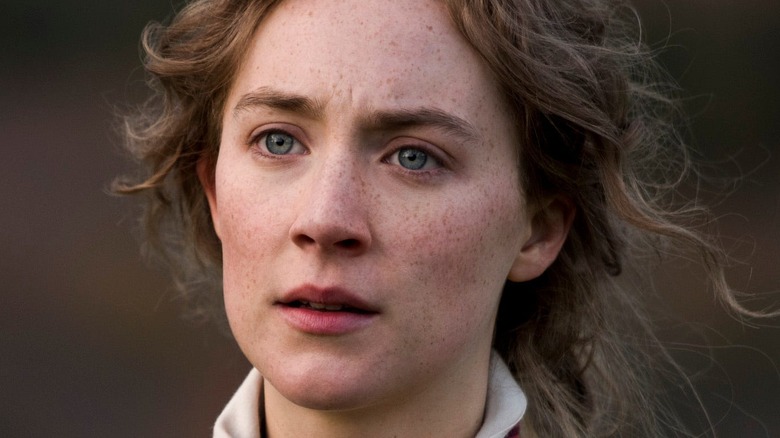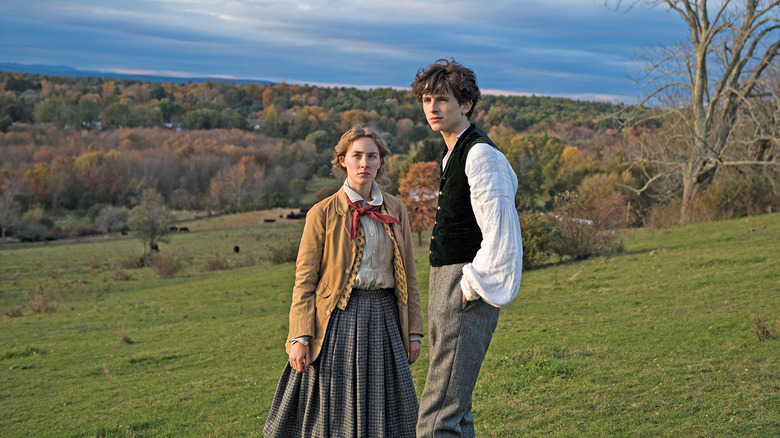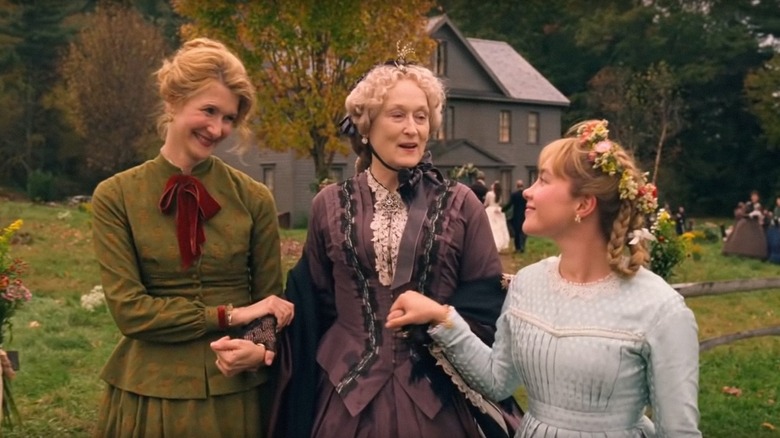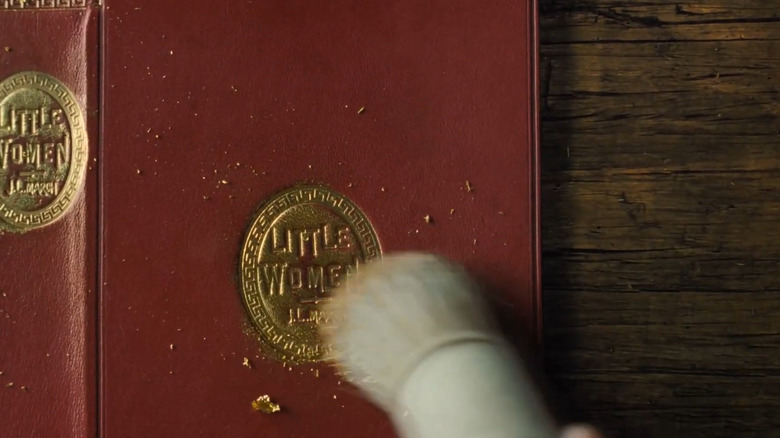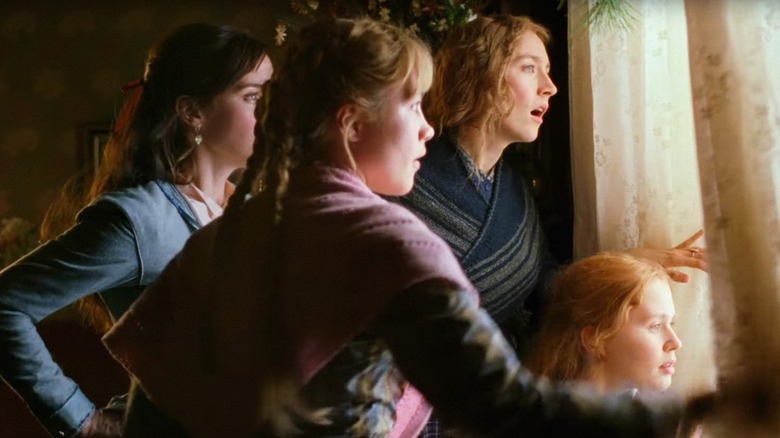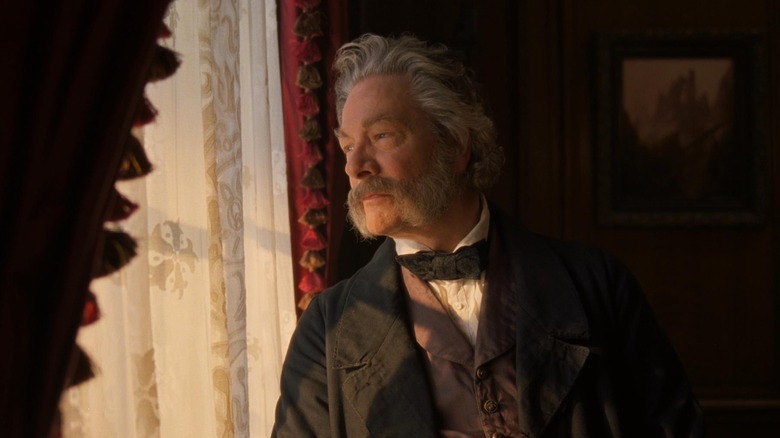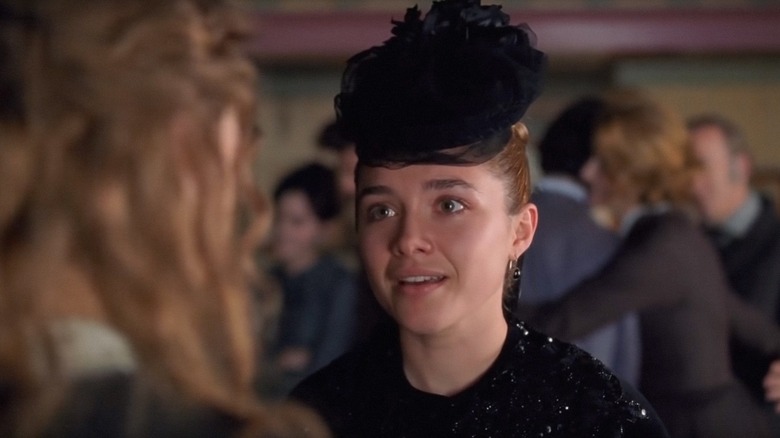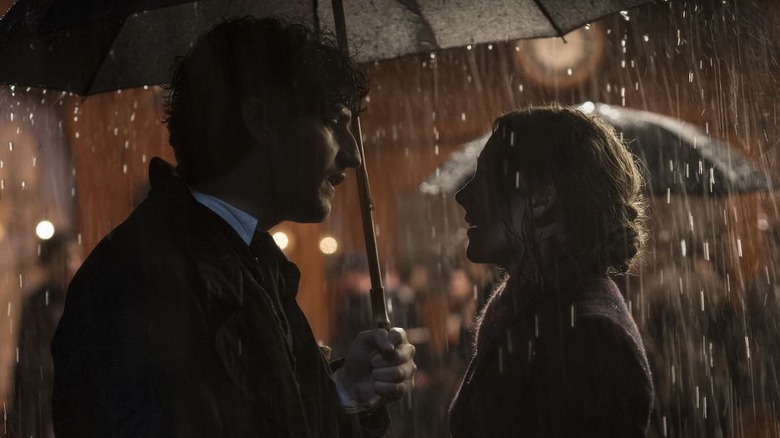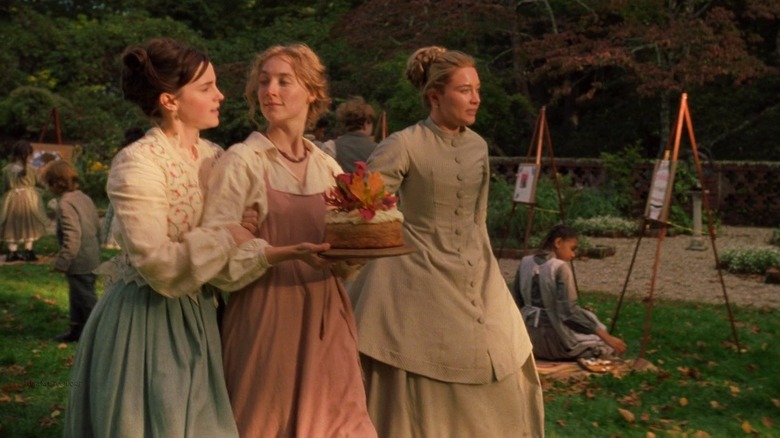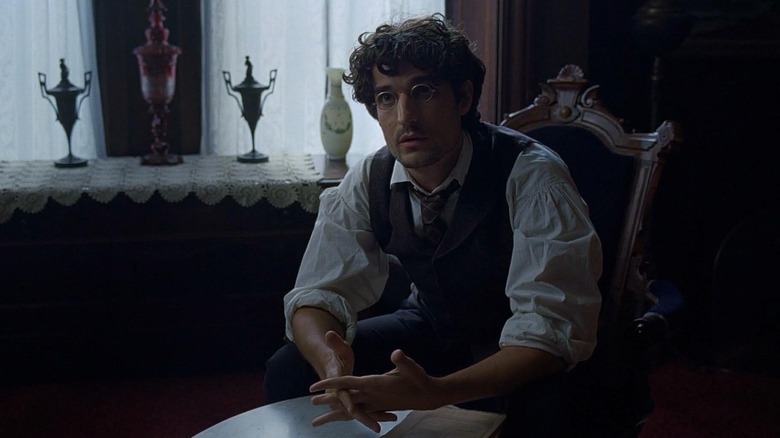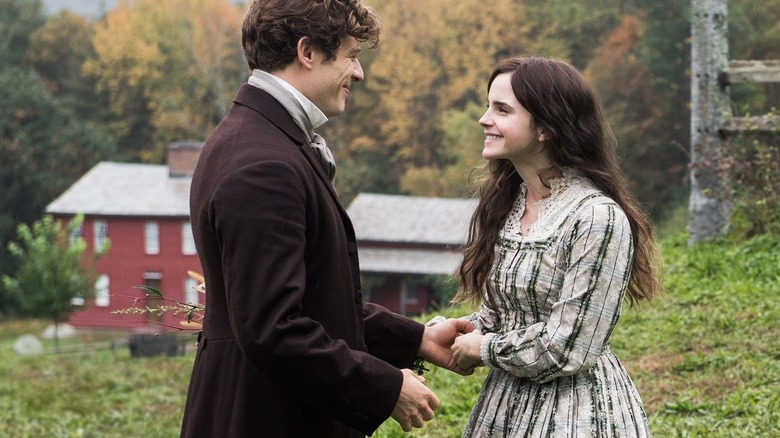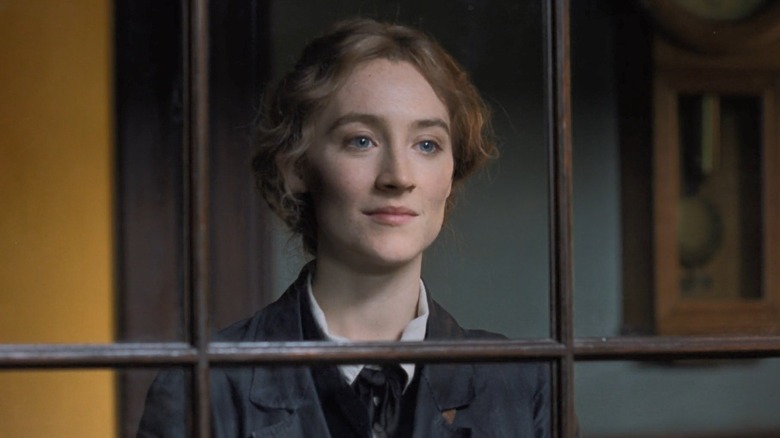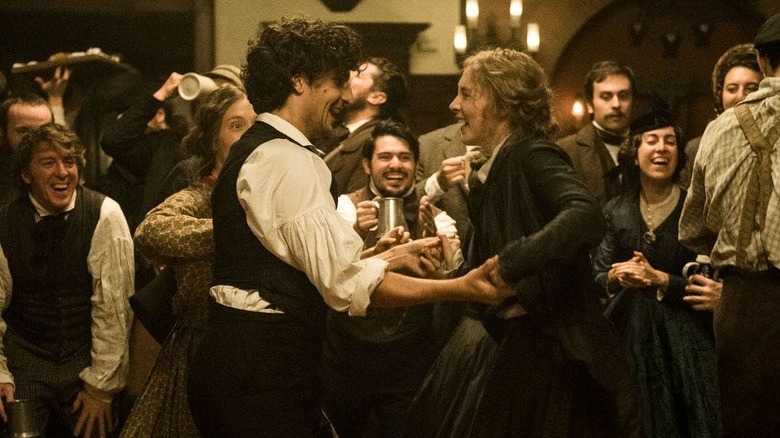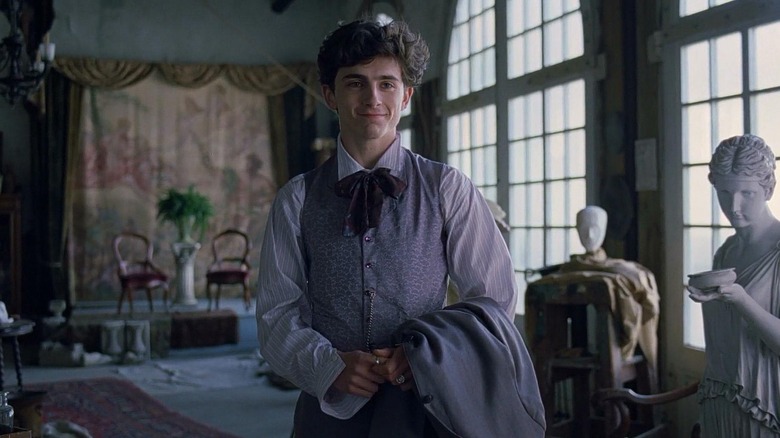The Biggest Differences Between The Little Women Book And The 2019 Adaptation
There are few novels that have been adapted for movies as often as Louisa May Alcott's 1868 classic "Little Women." The book has inspired a number of retellings not just in Hollywood, but film industries around the world due to its universal tale of sisterhood and the struggles of growing up in straitened circumstances.
In 2019, filmmaker Greta Gerwig came up with a fresh cinematic take on "Little Women" with an all-star cast of actors. As in the novel, the movie takes a look at the lives of the March sisters, a family of siblings on the cusp of womanhood living in the 19th century, and the challenges they face in finding personal and professional success in an era when women were greatly repressed on all fronts.
While Gerwig's adaptation sticks closely to the source material in some ways, it also takes daring risks with the narrative in other ways for a strikingly different take on "Little Women" than other films in the past. The movie was released to a great response from critics and made healthy profits at the box-office. Let us take a look at some of the ways 2019's "Little Women" is different from Alcott's original novel.
Non linear storytelling
When you're adapting a book that has already been made into films several times before, it can be difficult to find a new way to tell the story. Greta Gerwig side-steps this issue by using a non-linear narrative style instead of showing the events of the film in the order they occur in the book form of "Little Women."
The novel begins with the early days of the four March sisters — Jo, Meg, Amy, and Beth — who live with their parents in Massachusetts in poverty. From there, the story moves on to the sisters' adolescent phase as they begin to experience romantic love, and the question of marriage starts cropping up more frequently. The book ends with the main characters getting married off and/or finding professional success.
On the other hand, the movie begins with Jo (Saoirse Ronan) all grown up and seeking to publish her novel, which is based on her personal experiences. We then get flashbacks as Jo tells her story to her publisher (Tracy Letts), cutting to various moments in the lives of the March sisters without following a chronological order. This creates an air of mystery around various plotlines that develop in certain moments and get resolved in other moments viewed in different flashbacks.
Aunt March takes center stage
In the run-up to the release of "Little Women," the promos for the movie were careful to emphasize the fact that the movie stars Meryl Streep in the role of the forbidding matriarch Aunt March, due to her being a household name around the world. But this runs counter to the novel, where the character of Aunt March is more often heard than seen. The formidable aunt is supposed to represent the traditional thinking of the times that Jo and her sisters must struggle against, but Aunt March's views are more often relayed through a third party than coming from her directly.
The movie changes this up by having Aunt March be an actual flesh-and-blood person, played by Streep, who interacts with the main characters from time to time and is openly hostile to the way Jo and her sisters behave in their social and personal lives. Bringing Aunt March into the foreground was actually an idea that Streep herself proposed to the film's writer and director Greta Gerwig. "[Streep] loves the book and she told me ... 'I'll be Aunt March,'" Gerwig told The Hollywood Reproter. "[She said] 'Write me some good lines.' I was like, 'I will.'"
Lots of meta commentary
The original "Little Women" novel juggles a lot of complex storylines, but it is still a pretty straight-forward exploration of the lives of the March sisters and the challenges they face in their coming-of-age years. The 2019 film adaptation does things a little differently by throwing in lots of meta-commentary about storytelling from a female perspective.
This meta commentary element is introduced right from the first scene when Jo takes her new novel to her publisher. Through the process of talking to the publisher about her novel, which is itself called "Little Women," we get a lot of dialogue taking aim at the difficulty of being a female writer, the in-built expectations of the audience to wrap everything up with a neat bow, and the necessity of prioritizing commerce over true artistic vision.
Oftentimes, the movie feels like a running commentary on the struggles of making movies if you are a female. This was no coincidence, since it was an important theme that Greta Gerwig wanted to explore when pitching her idea for "Little Women" to the studio. "[The pitch for the movie] was about how the ambition and the dreams that you have as a girl get stomped out of you as you grow up," producer Amy Pascal told The Hollywood Reporter. "It was about the kinds of conversations that we all have about commerce and art and what we have to do to make things commercial."
Incorporating feminist issues
While "Little Women" is usually seen as a coming-of-age romantic novel, it has also been hailed as a feminist story long before feminism was a thing. The strong characterization of the March sisters and their determination to succeed in life on their own terms is one of the reasons their roles have always attracted high-caliber acting talent.
2019's "Little Women" wears its feminist influences very proudly on its sleeve, and adds little touches of modernity to the characters from the book that have inspired generations of men and women. The most prominent example of this is the main character Jo, who in the movie gets portrayed as a promising young writer, with her romantic problems being more of a subplot than the main driving force of the story. In the novel, however, Jo gives up writing to become a wife and mother.
Aside from Jo, her sister Amy (Florence Pugh) also gets to reflect various trends in women empowerment. She has a lot more lines in the movie than in the book of reflecting on women's unequal status in society, and she is very much depicted as a strong and capable character in her own right instead of just being the March sister that readers love to hate on.
Laurie and his grandfather get different roles
While the March family is the center of attention throughout "Little Women," another major family that gets introduced is the Lawrence clan. The most famous member of the family, of course, is Theodore Lawrence aka Laurie, but his wealthy grandfather Mr. Laurence is also an important member of the supporting cast of characters.
In the novel, Mr. Laurence is set up as an unofficial guardian angel to the March family early on, when he provides a sumptuous dinner to Jo's kin at the start as a reward for their giving up their own Christmas meal to more destitute children. We get many other smaller moments like these with Mr. Laurence and Laurie to show how close they are to the March family.
In the movie, the relationship between Mr. Laurence (Chris Cooper) and the Marches is not as fully fleshed out, although his biggest moment from the book where Mr. Laurence gifts Beth (Eliza Scanlen) a piano is retained in the film. Meanwhile Laurie's (Timothée Chalamet) relationship with the March girls is much more fleshed out, and he is shown to have an interest in all four siblings instead of focusing solely on Jo, taking part in their games and providing support during difficult times.
Amy is equal to Jo
In the novel "Little Women," Jo and Amy are presented as relatively extreme ends of typical girlhood. While Jo is headstrong and independent to a fault, Amy is spoiled and self-centered. While Jo dreams of having her own career and treats marriage as an afterthought, Amy wants a life of domestic bliss with Laurie even though she knows he is in love with Jo.
Due to this characterization contrast, most movie adaptations of "Little Women" cannot help but treat Amy in a slightly villainous manner, like the scene where she burns Jo's manuscript in a fit of rage. But the 2019 adaptation presents a much more sympathetic and well-rounded take on Amy as someone with different, but equally important priorities as Jo who deserves to find her own happiness.
Changing the way people see Amy was a priority for Greta Gerwig when she was making the film, as she told Deadline, "One of my experiences of reading the book was actually re-experiencing Amy as a profound character and equal to Jo." Gerwig goes on to point out that Amy's biggest sin in the novel appears to be that she is open about expressing her wants and desires, a quality which was considered shameful and immodest in women at the time, and Gerwig wanted to reassess why expressing "profound desires" would make a female character unlikeable.
The ending is open to interpretation
When "Little Women" was first released as a novel, it was hailed for being subversive in many ways. But in other ways it was quite traditional. A major concession to the traditions of the times can be seen in the way independent little Jo eventually gives up her dreams of becoming a writer to be married and settle down with a man much older than her named Friedrich Bhaer.
The 2019 film adaptation of the novel tries to strike a balance between honoring the source material and continuing to push the limits with a subversive ending. What we get as a result is a bit where Jo's publisher tells her that the novel she wrote based on her life needs to end in a traditional manner, so Jo tacks on an ending where her character marries Mr. Bhaer.
This leaves the ending open to interpretation, since there is no way to say for certain whether Jo actually got together with Bhaer or it was just something she wrote into her novel. According to filmmaker Greta Gerwig, the changed ending actually honors "Little Women" author Louisa M. Alcott's original plans for her book. "Louisa May Alcott never got married and she never had children," Gerwig pointed out during the DGA Podcast (via Collider). "But she was convinced that she needed to have Jo get married and have children in order to sell the book, but she never wanted that for her heroine."
A different spin-off premise
"Little Women" is essentially a coming-of-age story for its main characters, particularly Jo March. The character starts out extremely headstrong and independent, but the trials and tribulations of growing up transform Jo into a patient and selfless person who finally learns to put the needs of others before herself.
This change is reflected at the end of the novel. After dreaming of becoming a successful author her whole life, Jo gives up her dream to raise a family with her husband. More importantly, Jo starts a school for boys using the money and property her Aunt March left her in her will. The school becomes the focus in the sequel novel to "Little Women" called "Little Men," which sees Jo and her sisters in the role of experienced mentors to a new generation of kids.
In the 2019 movie, the school for boys is turned into a school for boys as well as girls of different races, where Jo teaches her students along with her sisters and their husbands. You also catch a few glimpses of scenes from the "Little Men" novel, like Amy and Laurie with their daughter Bess and the March sisters celebrating their mother's birthday.
Mr. Bhaer is hot and hip now
One of the biggest twists that Louisa M. Alcott pulls off in her novel "Little Women" is with regard to the main character Jo March's romantic destiny. All through the book it seems like Jo is going to marry the dashing, devoted Laurie, only for her to end up with Friedrich Bhaer, an impoverished professor who helps Jo improve her writing skills.
Bhaer was never meant to be a classical romantic figure, which is why he is shown to be much older than Jo and a bit of a plain-looking guy in the novel. But the 2019 adaptation makes the character much younger and closer to Jo in age and spirit, so they appear to be on equal terms instead of the "student-teacher" dynamic that is found in the novel. It is also significant that the film's version of Bhaer is played by Louis Garrel, whose dashing good looks make the character seem like a Disney prince rather than a stodgy old professor.
According to filmmaker Greta Gerwig, Bhaer's changed appearance was an important part of making the movie reflect female desire in all its forms. "With the characters of Professor Bhaer and Laurie, I did want to introduce the feeling of 'What if we treated the men in this movie the way we usually treat girls?'" Gerwig told Thrillist. "To make Professor Bhaer incredibly handsome was another example of movie-making and making him what we think of as a movie romantic character."
Meg's romance gets shortchanged
"Little Women" is a lengthy novel, which means that any movie adaptation of the book must out of necessity cut major chunks from the source material to keep the film under two hours. One character that often gets the short end of the stick in this regard is Meg, the oldest March sister, played in the 2019 movie by Emma Watson.
In the book Meg has her own story arc that starts with her going to spend time with her wealthy friends in the city. Meg meets the handsome, but poor, John Brooke. The two fall in love but are prevented from marrying because of John's poverty and Meg being underage. Then they have a drawn out courtship period during which to figure out their true feelings for each other.
In the movie, the courtship is reduced to some longing glances between Meg and Brooke, played by James Norton, before the two get married. Another important part of Meg's journey in the book was showcasing the period immediately after marriage, when John and Meg struggle to adjust to each other and their life together. This struggle is only shown briefly in the movie in a sequence where Meg buys a piece of silk that is far too expensive, leading to a difficult confrontation with her husband.
Jo is a stand-in for her creator
The novel "Little Women" as written by Louisa M. Alcott was closely inspired by her own life of growing up with her three sisters. As such, the novel sees Alcott transcribing her own thoughts and feelings to the characters, particularly Jo, and in Greta Gerwig's film adaptation, the lines between Jo and Alcott are greatly blurred.
Jo, in the movie, ends up writing and publishing the novel "Little Women," just as Alcott did in real life. Then there is the fact that one possible interpretation of the end of the film is that Jo remains unmarried and unattached. This again reflects the real life Alcott, who remained unmarried throughout her life. "This was an adaptation that was very different than anything I'd ever seen before," producer Amy Pascal told The Wrap about Gerwig's pitch for making the film. "She made [Little Women] about Louisa May Alcott's own story and the process of publishing the book."
Taking the idea even further, Gerwig drew from Alcott's private correspondence that is available to the public and inserted lines from other novels written by Alcott into the script for her film, including the famous scene in which Saoirse Ronan's Jo declares passionately, "Women, they have minds, and they have souls, as well as just hearts."
Becoming more like a rom-com
Oftentimes, film or television adaptations of existing works make the mistake of treating the source material too reverentially, taking away any hint of fun or playfulness the original text might have had. When Greta Gerwig set out to adapt "Little Women," though, she went in the opposite direction, infusing the script with levity and a sense of fun that even outdoes the novel at times.
Case in point: the relationship between Jo and Friedrich Bhaer. In the novel, the romance takes places staidly over a course of months and years before culminating in a low-key proposal by Bhaer that Jo demurely accepts. But the movie creates a spirited romantic comedy out of the Jo/Bhaer pairing. Starting with a meet-cute during which Jo's skirt accidentally catches fire in Bhaer's presence.
We also get the classic rom-com second-act misunderstanding between the lead pair when Jo gets mad at Bhaer because she thinks he is being unnecessarily critical of her writing. Finally, we get one of the most often used tropes in rom-coms, where the guy runs after the girl to the airport — only, in this case, it is Jo who races after Bhaer in a horse carriage before he can leave for California, and the two are finally reunited under pouring rain with romantic music blaring in the background.
Laurie looks different in the book
While "Little Women" is all about the March sisters, it also has several important male characters. The most well-known one is Laurie, a wealthy orphan who befriends the March siblings, falls in love with two of them, and ends up marrying one after getting rejected by the other. The 2019 adaptation of the novel gives Laurie more prominence as a friend than a lover.
While Timothée Chalamet does a good job of portraying the character in the movie, he is unable to bring to the screen an essential part of Laurie. In the novel Laurie is described as having brown skin and big black eyes. Basically Laurie in the book does not look like a traditional white guy, while Chalamet very much does. This difference might appear only cosmetic, but it actually has deeper significance in the book.
It is written that Laurie's grandfather disowned his son for marrying an Italian woman, and it can be inferred that Laurie is kept isolated from society by his grandfather due to his mixed heritage and non-white appearance. This means that a possible reason for Laurie seeking out the lower class Jo and her sisters is because he is considered an outsider in his own social circles. All this subtext is lost in the movie, where Laurie looks like any other white dude and hangs out with the March sisters simply because he likes their company.
